#Online Print Handwriting Improvement courses
Explore tagged Tumblr posts
Text
The 5 best passive income ideas for Artists
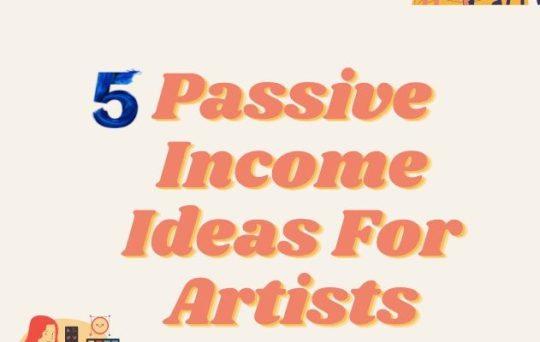
Artists can benefit from passive income since it allows them to spend more time doing what they love (art) and less time worrying about their next paycheck.Artists are inherently creative individuals, yet making money as an artist may be difficult due to the subjective nature of the field.This is why it is critical for many artists who want to take their artistic activities to the next level to ensure they have a means of generating revenue.1. Print-on-demand sitesPrint-on-demand platforms allow you to have your artwork printed on a variety of various goods, such as iPhone covers and wall clocks, as well as tote bags and wall art. It’s a terrific method to have a consistent money flow coming in, and if your art is exceptional enough, you will enjoy long-term earnings.2. Create and sell contentAs an artist, your natural inclination is to be inventive and create works of art that stand out. So, creating and selling your artwork is one of the simplest ways for you to locate and produce passive cash. On Penkraft’s sister portals, you may sell your artistic creations to domestic and international clients without paying a fee. It allows you to express yourself creatively.
3. Teach Art OnlineCreating and selling online courses based on your skill set is one of the finest ways to look at passive income for artists. Becoming a Penkraft teacher is the best way of doing exactly that!
Penkraft
helps you to start your home-based art classes and provides lifetime free marketing support. Penkraft DOES NOT charge any royalty. Penkraft certified course kits can be bought on Penkraft’s website at discounted prices.4. Create a blogBlogging is all the rage these days, and you have the benefit of being able to monetize your blog as one of the finest types of passive income for artists.This is a great money stream to explore, but there are a lot of variables to consider, so make sure you do it right and blog as effectively as possible.5. YouTube channelYouTubers are quite famous these days, and it is well worth your time as an artist to make video material. You can do a lot with your YouTube channel, which is why it’s crucial to establish one in order to generate more interest in your work.Finding a strategy to monetize the channel might also provide you with a source of passive revenue.
Call us on +91 7304044597 / 98 or mail us at [email protected] and we will prepare a tailor-made digital marketing solution for you that will be effective, efficient and ‘value-for-money!
Penkraft conducts classes, course, online courses, live courses, workshops, teachers' training & online teachers' training in Handwriting Improvement, Calligraphy, Abacus Maths, Vedic Maths, Phonics and various Craft & Artforms - Madhubani, Mandala, Warli, Gond, Lippan Art, Kalighat, Kalamkari, Pichwai, Cheriyal, Kerala Mural, Pattachitra, Tanjore Painting, One Stroke Painting, Decoupage, Image Transfer, Resin Art, Fluid Art, Alcohol Ink Art, Pop Art, Knife Painting, Scandinavian Art, Water Colors, Coffee Painting, Pencil Shading, Resin Art Advanced etc. at pan-India locations. With our mission to inspire, educate, empower & uplift people through our endeavours, we have trained & operationally supported (and continue to support) 1500+ home-makers to become Penkraft Certified Teachers? in various disciplines.
0 notes
Text
#Print Writing#Handwriting Improvement#Print Handwriting#Print Handwriting Improvement#Print Handwriting Improvement Course#Print Handwriting Improvement Classes#Print Handwriting Improvement Online Course#Print Handwriting Improvement Online Classes#Online Print Handwriting Improvement#Online Print Handwriting Improvement courses#Print handwriting improvement for kids#Print handwriting improvement for children#Print handwriting improvement for students#Print Handwriting Improvement training#Certified Print handwriting improvement course#Print Handwriting Improvement Classes near me#handwriting Improvement certificate#Handwriting improvement course#Handwriting improvement classes#handwriting Improvement certificate online#handwriting courses#handwriting courses online#handwriting classes#handwriting classes for kids#handwriting classes near me#penkraft#penkraft certified course#penkraft near me#penkraft certified online course#how to improve handwriting
0 notes
Link
Penkraft Certified Online Courses in Handwriting improvement,for Students, kids, Women`s, Homemakers.
0 notes
Text
headcanon #11: peter and bucky stress bake together
Bucky picked up baking as a coping mechanism and often when he has nightmares, he’ll wake up and go downstairs to the compound’s kitchen and just bake until his heart has stopped racing and his head is quiet.
Peter’s a night owl who’s just always up at odd hours, whether that’s completing the homework he left until last minute, watching a film, playing video games, or completing his mission to explore every single room in the compound.
On one of his late night walks around the compound, Peter smells cupcakes baking, which is weird because it’s 3AM and which of the Avengers bake during the day, let alone in the middle of the night? He goes to check it out, and lo and behold it’s Bucky Barnes barefoot, in sweatpants and a grey long sleeve t-shirt, just silently baking. There’s a tray of cupcakes in the oven, another cooling on the counter, and he’s currently spooning more batter into empty cupcake cases.
Peter justs stands in the doorway, watching. He doesn’t want to disturb him because he looks so at peace, but it’s fascinating watching the notorious Winter Soldier going through the motions of baking with such practised ease.
Bucky has his back to him, but he know’s Peter’s there, because of course he does - he has super soldier serum, and he can see him in the reflection of the over door. He doesn’t say anything or acknowledge him, though. If the kid’s not going to say anything, then neither will he. And, to be honest, he hasn’t quite acclimated to talking to any of the other Avengers yet, except for Steve and occasionally Sam and Nat, if he’s feeling up to it.
This happens a few times - Bucky will be baking in the middle of the night, and Peter will just watch from the doorway. Every night where Peter finds himself awake at ungodly hours, he checks to see if Bucky’s baking in the kitchen again. Sometimes he is, sometimes he isn’t. If he is, Peter will watch, otherwise he’ll just go back to whatever he was originally.
After a few weeks of Peter watching him, Bucky starts to leave a little plate of whatever he has baked in the fridge, wrapped in clingfilm and labelled ‘Peter,’ because he wants the kid to have some, but the rest of the team normally eat all of what he’s made before Peter even gets up. It absolutely thrills Peter that Bucky is thinking of him and that he gets to try the baked goods.
(Peter’s favourite thing that Bucky has made has got to be the apple and cinnamon cupcakes - not because he liked the flavour, because who the hell puts fruit in a cupcake? No, Bucky had decorated the cupcake with two little lightsabers, knowing that Peter absolutely loved Star Wars.
Unbeknownst to Peter, Bucky had seen him find the cupcake and had seen him smile unabashedly to himself. So, after that, whenever Bucky made cupcakes or sugar cookies or anything he could decorate with icing, he always made sure to decorate one specially for Peter.)
After the Star Wars cupcake, Peter stopped standing in the doorway. Yes, okay, he sat on the barstool that was all of a metre from the door, but that’s not the point - at least he wasn’t stuck standing for however long Bucky baked for, anymore.
Sometimes, when Bucky would hear the sound of the barstool scraping against the tiles, signifying Peter’s arrival, he would glance at Peter and give him a small and quick smile, before going back to his baking. Other nights, when the nightmares were worse, he wouldn’t. But, regardless, Peter’s presence was nice, it was calming.
Weeks go by, and Peter gets caught up in studying for mid-terms, so he doesn’t get to watch Bucky bake as much as he’d like to. One night, when he’d been staring at the same page of his American History textbook for the past hour without taking anything in, he decided to take a walk to the kitchen, to see if Bucky’s there, figuring he deserves a break.
And he is. Except this time, in the space beside Bucky’s workstation, which is normally left empty and spotless, there’s a bag of flour, sugar, 3 eggs, some other ingredients that Peter can’t identify from this far away, measuring equipment, bowls, and a— a piece of paper? He walks over to see what it is, and it’s a piece of lined paper, torn out from a notebook, covered in what he presumes to be Bucky’s handwriting.
A recipe, his mind supplies.
It’s for him, he realises. Peter’s never been the best at baking - he’s too impatient - but right now, baking seems like the best thing he could do. So, he reads the first instruction on the recipe, following it as precisely as he can.
Peter and Bucky don’t talk that night, instead baking in silence. Peter’s cookies come out a bit crispy around the edges, but it’s fine, it was relaxing anyways, and that was what both of them needed.
Now every time Bucky finds himself in the kitchen, baking in the middle of the night, he leaves out ingredients and a recipe for Peter. Sometimes he’s there, sometimes he isn’t.
They still don’t talk much, save for the occasional, “Can you pass me the measuring spoons, please?” or “Can I have the butter, please?” or “Do you mind if I borrow some of your sugar?”
On the nights they bake together, Peter starts to leave post-it notes with film titles on them that he thinks Bucky will enjoy.
Slowly but surely, Peter’s baking improves. He doesn’t know it, but Steve taste-tests everything he bakes. Each night, after they’ve finished baking, after Peter has left and Bucky has cleaned up, Bucky always brings a plate of Peter’s latest creations back to Steve for him to try, all excited about “Look what the kid made this time!” and “He’s improved so much already, don’t you think?”
Over the months that they bake together, it eventually becomes Peter’s coping mechanism, too.
Some nights, even, when Bucky wakes up from a nightmare and trudges to the kitchen, the light will already be on, and Peter’s there in the middle of baking something. Bucky will usually find unopened ingredients already in the space where he normally works, and a whacky recipe waiting for him that Peter has found online and printed off, wanting him to try it out.
Some nights, they don’t even bake. They’ll just mix together a massive bowl full of the ingredients for cookies or a cake, and then just eat raw cookie dough or cake batter together, straight out of the mixing bowl.
Neither of them tell Steve or Tony about their secret guilty pleasure, because they both know that they would have their necks if they found out Peter and Bucky were consuming large amounts of raw egg on a semi-regular basis.
Those are their favourite nights, though.
#canon divergence#found family#stress baking#not a ship#marvel#mcu#marvel cinematic universe#bucky barnes#winter soldier#sebastian stan#spider man#peter parker#tom holland#the falcon and the winter soldier#tfatws#spider man no way home#stevebucky#stucky#marvel headcanons#mcu headcanons#avengers#the avengers#iron man#captain america#black widow#the falcon#avengers headcanon#spider man imagine#bucky barnes imagine#peter parker imagine
97 notes
·
View notes
Video
youtube
Catch a glimpse of our Online Print Handwriting Improvement Course and understand how this course will help you / your child improve their handwriting, as ONLINE is the "New Normal". This is a structured, module-based 30-hour online course to be completed in 40 days. In this course, your child will learn the best practices of posture while writing, positioning of the notebook and writing habits. The course further guides the child with the basic strokes and its associated group of letter formation, both capital and small letters along with punctuation. The course also helps to recognize and understand the letters, letter spacing, interword spacing and use of Upper-case and Lower-case letter where appropriate while writing the sentences in the paragraphs, which helps the child to easily switch from Four-liner book to single line book. This course is the best guide for children to self-assess their current and improved handwriting. The course fee is slashed to INR 999/- Enroll NOW! For queries and guidance, contact us 98194 45126/ 73040 44598. Or you can drop your number in the comment box and we will call you back. Visit penkraftonline.in
1 note
·
View note
Photo
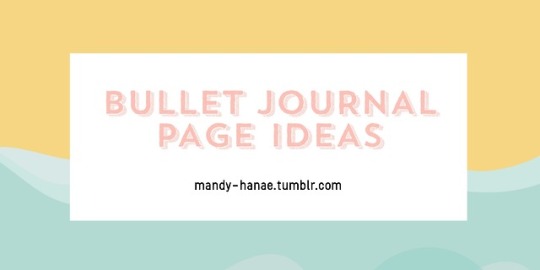
Forewarning: an exceedingly long list of bullet journal page ideas below :)
Hi everyone, it’s been a while! So, long story short, I’ve made a very long list of bujo page ideas that I think are useful, interesting + fun! Fyi, I’ve arranged the ideas (i.e. the bullet points) under each categories according to my own priority + interests. Also, I’ll be updating this list from time to time, so feel free to suggest new ideas simply by replying this post! ;)
planning
index (table of contents)
key, legend, specifier
goals (daily, weekly, monthly, yearly, future)
goals (short-term, long-term)
new year resolutions / goals
daily spread / log (routines: morning, evening, night)
weekly spread / log / schedule
monthly spread / log / review
future log / yearly calendar
x-year plan (where x = number of years)
to-dos / tasks (daily, weekly)
10 minute tasks
reminders (daily, weekly, monthly, yearly)
important dates
deadlines
birthdays
anniversaries
holidays / special days
appointments / events
diary / journal
trip / travel / holiday / vacation planning
wedding planning
progress tracker (events, goals, etc)
vehicle maintenance (timeline, checklist)
home maintenance (timeline, checklist)
bullet journal (aka bujo)
bujo routine
bujo hacks / tips
bujo themes
header / banner ideas
doodle / drawing ideas
doodle page (doodle a day challenge)
sketchbook (doodling / drawing pages)
title + sub-title ideas
date ideas
divider ideas
layout / spread ideas for bujo
handwriting page
font page
hand lettering / brush lettering / calligraphy
washi tape collection / swatches
pen colours swatches
highlighter colours swatches
brush colours swatches
water colour samples
stationeries / art supplies wishlist
stationeries / art supplies inventor
practice page (hand / brush lettering, doodle, drawing, colour combination, etc)
page to try out new stationeries (pens, markers, highlighters, brushes, etc)
full-page journal entries
bullet journal page ideas
bujo goals
what is bujo + how to bujo? (bujo introduction + guide)
journaling techniques
lifestyle
habits to break
new habits to adopt
chores list / tracker
shopping list
cleaning routine / schedule / tracker
tidying days tracker
laundry tracker
productivity tracker
outfit planning / inspiration / ideas
time management tracker
work / job / career history + timeline
financial
no buy list
no spend days tracker
money-saving tips
savings goals
savings tracker
spending / expenses tracker
monthly budget tracker / planning
debt payoff tracker
income tracker
income growth tracker
bills tracker
gas mileage tracker
self-care / self-improvement
self-care activities / tips
about me (self-introduction)
bucket list
wishlist / wish board
vision board
abstract feelings (drawing therapy: express my feelings, draw my emotions out)
things that make me happy
hobbies tracker
new hobbies to try
hug / cuddle tracker
what do I enjoy + love? / things I enjoy + love
things I got into recently
dream journal / log / tracker
highlights this past year
experiences this year
“fuck it” page (vents / rants; let all those swearings out)
memories of the month
memories / special moments you don’t want to forget
in-do list (things I’ll quit doing)
my horoscope / zodiac sign info
my personality test result / mbti type info / my personality traits
small things that matter
everyday “nothings” I’m grateful for
timeline of my life
map of my life
happy thoughts
notes to self
positive affirmations
sentence-a-day log
one-liner journal
letter to past / future self
personal stories / thoughts (like diary)
random thoughts
skills to learn
things I want to learn
reward tracker
gratitude tracker (things, people)
20 goals before 20
30 goals before 30
things that are stressing me out
how to reduce the things that are stressing me out?
learned lessons / things to reflect on
things to improve
things I love about myself / what I love about myself?
how to stop self-hate / self-loathing?
my values
how to live out my values?
things I’m proud of
things I didn’t do as much as I liked
“flaws” I am grateful for + why
comments
advices
level 10 life
life goals list / tracker
resolutions page
achievements / accomplishments in life
what am I working / fighting for?
how to succeed?
“one smile a day” challenge
my observations about people
where do I want to be in x years? (where x = number of years)
read at least one chapter log
health
hydration tracker (water intake log)
menstruation tracker
mood tracker
relaxation tracker
methods of relaxation
sleep tracker
healthy meals / snacks ideas / options
healthy meal planning / tracker
snacking tendencies tracker
food to eat / avoid list
no x days (where x = food to eat less; e.g. snack, junk food, alcohol, sugar, carbs, etc)
how to cope with mental illness? / mental health management (depression, stress, anxiety, etc)
step count tracker
daily step count goals
energy tracker
migraine tracker
meditation tracker
mental health tracker
meal / food tracker
meal / menu planning
recipes to try / things I want to cook
ratings on things I cooked
favourite recipes
medicine tracker
skin care routine
calorie tracker
exercise / workout tracker
fitness tips / guide
fitness goals
fitness routines / sets
measurements tracker
weight loss / gain tracker
bmi tracker
yoga tracker
yoga poses to try
study (school, university, college)
printables / print outs
things to do before a new semester starts
academic / semester calendar
classes / lectures schedule (timetable)
assessments tracker (assignments, lab reports, projects, homeworks, etc)
project / assignment planning / breakdown (brainstorming new ideas)
important dates (upcoming tests, finals, group discussions, etc)
deadlines tracker (assessment due dates)
study plan for a subject / course / class
studying schedule / timetable/ routine
studying / revision tracker (study hours log)
revision checklist (topics, chapters, subjects, courses, etc)
scholarship activities / events
definitions list
formulas list (maths, chemistry, etc)
vocabulary to learn list
semester goals
grades / exam results tracker
study / school / university supplies list
study / learning websites
reference books / textbooks to buy
study space layout (actual / dream study space)
dream study space ideas
organization tips / ideas for university
productivity tips / ideas for university
before-class routine / checklist
hours spent in library
study tips / hacks
improvement tracker
note-taking method / system
color-code system
studying techniques / methods
how to study smart / efficiently?
how to stay motivated?
how to focus in class?
how to get good grades? / how to improve grades?
how to stop procrastinating?
tips for time management
syllabus / modules list
lecturer / professor / teacher info
past papers tracker
how to overcome failure?
“funny / weird things that happened in university” list
best campus food
favourites
stationeries (pens, markers, highlighters, brushes, etc)
food / meals (desserts, snacks, beverages, drinks, etc)
swatches (stationeries: pens, markers, highlighters, brushes, washi tapes, etc)
colours / colour schemes / colour palettes / colour combinations
hobbies / pastimes
movies / tv series / documentaries / anime
books / manga / manhwa / manhua
genre categories (movies, tv shows, anime, books, manga, music, etc)
songs / playlists / albums / podcasts
lyrics
song artists / bands
apps
ice cream flavours
things / items / products I own (skincare, makeup, etc)
seasons
font types
words
quotes
podcasts
brands (notebooks, clothings, skincare, makeup, etc)
cafes / restaurants
animals / pets
holidays
plants (flowers, leaves, etc)
stores (online / physical stores)
indoor + outdoor activists
poetry
recipes
presents / gifts
feelings
people
aesthetics
celebrities / influencers
characters
blogs / tumblr blogs / websites / youtube channels / instagram accounts
six word stories
scent / smell
fruits + vegetables
sports
checklists
organization ideas / tips
tea / coffee consumed tracker
to watch (movies, tv series, documentaries, anime, etc)
to read (books, articles, manga, manhwa, manhua, etc)
to listen to (songs, playlists, albums, podcasts, etc)
to buy (groceries, shopping, etc)
to try (food, beverages, activities, etc)
to visit (cafes, restaurants, etc)
to travel (places: countries, states, cities, etc)
things to try / attempt
craft / diy project ideas to try
zero waste tips / habits
green living tips / habits
packing checklist (travel, trip, vacation, moving, etc)
adulting list (things I need to learn to become an adult)
maps (colour the place you’ve visited)
before-bed checklist
road trips
random acts of kindness
destinations / places to travel with friends
progress tracker (e.g. book series: pages, chapters, volumes; tv shows: episodes, seasons; podcasts progress, etc)
boredom buster list (fun things to do)
lists
usernames + passwords
playlists for certain moods / occasions
new music discovered
new songs added to playlist
gift / present ideas
things I googled
foreign language vocabulary to learn
new vocabulary
inspirational / motivational quotes
questions I want answers to
story / plot ideas
character ideas
beautiful words to use more often
untranslatable words
365 words to learn (learn a new word per day challenge)
addresses
convenient / useful knowledge
useful unknown facts
interesting / random facts
important contacts / emergency contact info
upcoming releases of things that I like / love (release dates)
pros + cons list
outfits / clothings I own
fashion / outfit inspiration (print outs, magazine cut outs, etc)
how to make someone happy
authors to know
the most important people in my life
collections
flowers / leaves (dried / pressed)
polaroid pictures / photos
swatches (pens, markers, highlighters, brushes, washi tapes, etc)
fortune-telling paper strips / fortune cookie fortunes / amulets
ticket stubs / tickets (movie, train, amusement park, concert tickets, etc)
receipts
stamps (ink)
postage stamps
clothing tags
bookmarks
maps + brochures from travel
greeting cards / postcards
food wrappers / packagings
wrapping papers from gifts you’ve received
cute paper / gift bags
stickers
magazine / book cut outs
business cards
books purchased (titles, date + place of purchase, etc)
social media (blog, tumblr, instagram, pinterest, youtube, etc)
content / post ideas (planning)
social media planning (timeline, content, event, etc)
followers / subscribers count
blog goals
blog information
blog statistics
content updates
social media tracker (time spent on social media)
blogs, tumblr blogs, instagram accounts, youtube channels, pinterest boards, websites, etc to follow
fun
room layout / dream room ideas / room decoration ideas
dream home ideas
aesthetic page (mood board, style board, inspirational photo board, etc)
morse codes
brain dump
brainstorming
pretty + cute things (literally anything pretty + cute)
song of the day
art journal
collage art
colouring page
pen tests page (scribbling page)
random notes
things to look forward to
countdown to a special day / event
“don’t break the chain” challenge
100 days of productivity
moon phases tracker
musical pieces you’d like to play
journal writing prompts
cryptography
invention ideas
best purchases made
“if I had a million dollars”
pet care log
plant care guide + log (plant watering, etc)
family tree
food / snacks / beverages reviews
restaurant / cafe reviews
places travelled review
movies / tv series / anime reviews
book reviews
constellation chart
30 day challenges
hogwarts houses
zentangles
knitting patterns
things that my friends like
friends page (where my friends write stuffs in)
tattoo ideas
philosophical stuffs
#bulletjournals#bulletjournal#bujo#bujowithme#bujotime#bujo tips#bujoy#bujoideas#bujoinspire#bujo pages#bujo planner#bujoph#bujo aesthetic#bujoaddict#bujospiration#bujogram#bujogirl#bujo goals#bujohack#bujojunkies#bujojunkie#bujolove#bujolife#bujochallenge#bujocommunity#bujo spread#bujoblr#bujobeauty#bujonerd#bujo motivation
5K notes
·
View notes
Text
Brief History of Type

Printing with moveable type actually started in China and Korea in the 8th century AD and printed type (via wood block printing) began to be distributed. In Japan, a devout empress commissioned one million copies of a prayer for distribution to pilgrims. During this time a print runs took six years to complete.
In the middle of the 15th century a German goldsmith Johannes Gutenberg invents moveable metal type and the printing press.

Print and typography were transformational in many ways. For example, typography helped seal the notion of “text” as a complete work, a stable body of ideas in one form.

Before the printing press, books were produced by scribes circa the 12th century.
When Gutenberg produced his first typeface, he designed the typeface that was popular at the time. This first type was called “Black letter”.

Black letter is a descendant of “Caroline minuscule”, a calligraphic script developed in Charlemagne’s empire (800-1100 AD). Blackletter soon got competition from "humanist" typefaces created during the 15th century by Venetian printers. These typefaces looked more like writing found in the humanistic (renaissance) manuscripts of the time. Most printers started using “humanist”-style fonts but Germans were not swayed: they used Blackletter or “Fraktur” until the 20th century.
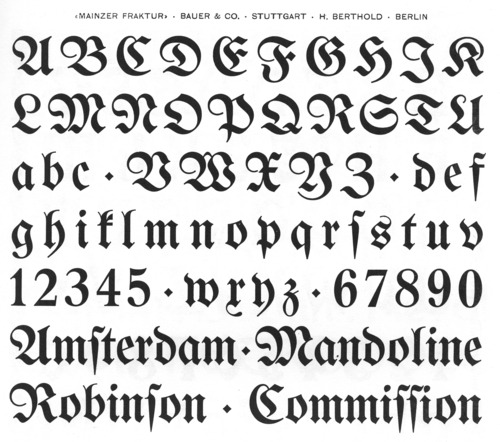
In the first decades after the invention of print, type designers drew their inspiration from handwriting or calligraphy. Frenchman Claude Garamond completed the development of transitional typeface with his typeface. Garamond gives up on trying to imitate handwriting, for him, type becomes its own art. “Garamond” becomes the most popular typeface in Europe.
Transitional typeface “Transitional” type is so-called because of its intermediate position between old style and modern. The distinguishing features of transitional typefaces include vertical stress and slightly higher contrast than old style typefaces, combined with horizontal serifs.
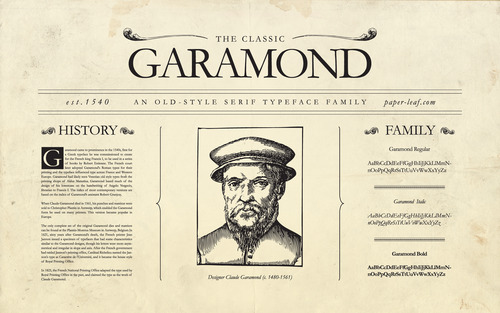
Master calligrapher John Baskerville (1706–1775) wanted to improve legibility and worked hard to create typefaces with sharpness and contrast unlike anything else at the time.
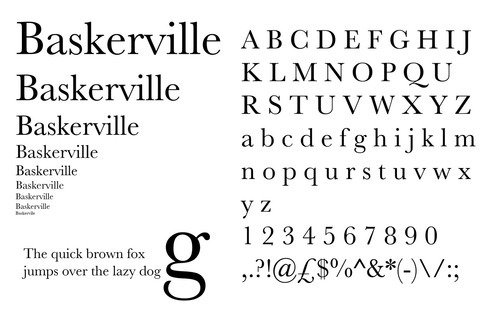
Firmin Didot (1764–1836) created what is considered the first Modern typeface. ``Modern’’ typefaces are distinguishable by their sudden-onset vertical stress and strong contrast. Modern serifs and horizontals are very thin, almost hairlines. Although they are very striking, these typefaces are sometimes criticized as cold or harsh, and may not be quite as readable for very extensive text work, such as books.

The industrial revolution shaped the 19th century - and it also shaped typography. Mass production led to mass consumption, which led to mass communication. Advertising exploded and with it the need for bold in-your-face type, soon typefaces of all widths and heights appeared. Serifs lost their role as finishing details and became independent components.
20th Century In the early 20th century avant-garde artists went a step further in rejecting historical letterforms. Following the Bauhaus credo of radically simplified forms and functionality, Paul Renner designed Futura based on simple geometric shapes. In his quest for simplicity, Renner avoided all decorative non-essential elements.
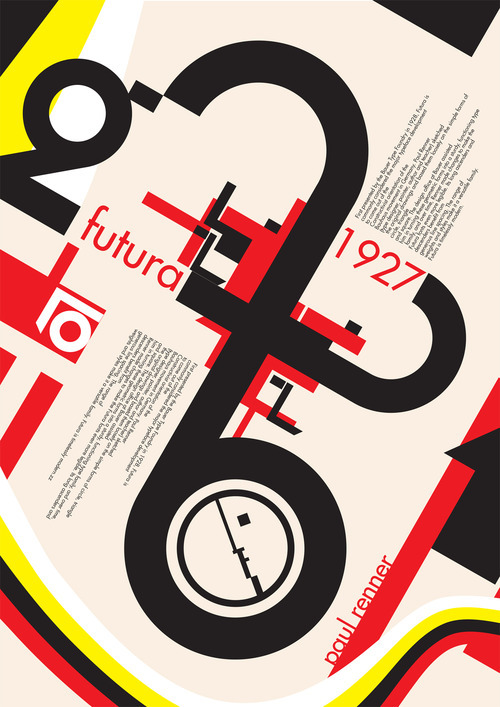
Futura has a refined yet cool element, so when Swedish furniture retailer IKEA abandoned Futura in their catalogues for Verdana (a Microsoft-produced online font), it received severe complaints from customers.
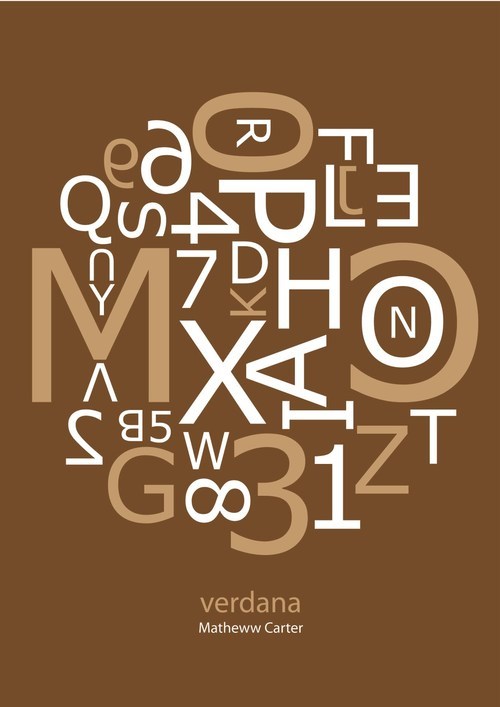
1957 Helvetica is everywhere. Born in neutral Switzerland in 1957, its neutrality soon took the world by storm. Business quickly embraced the clear but honest look and soon it became the font of choice for logos, transport signs, and product packaging. Today, it is virtually impossible in America to spend a day without somehow seeing the font.
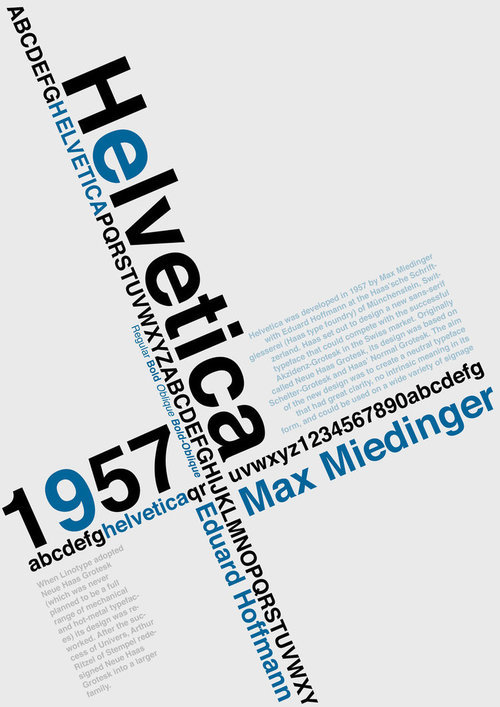
1950’s After the proliferation of typefaces Concrete Poetry became popular. Coined in the 1950’s Concrete poetry or shape poetry is poetry in which the typographical arrangement of words is as important in conveying the intended effect as the conventional elements of the poem, such as meaning of words, rhythm, rhyme and so on.

It is sometimes referred to as visual poetry, a term that has evolved to have distinct meaning of its own, but which shares the distinction of being poetry in which the visual elements are as important as the text.
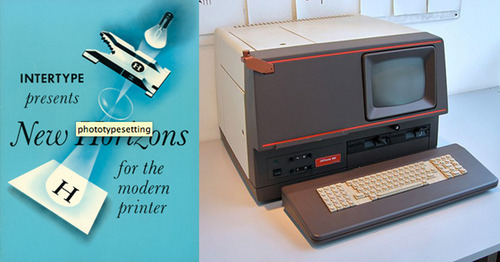
Phototypesetting, 1950s: this machine projects light through a cut-out of a font character, onto a film that is then treated chemically to bear the mark permanently. This system has the advantage of scalability — magnifiers can be used to adjust the size of the type image freely, without having to bring in a new font cutout. Of course, digital vector technology would soon leave this advancement in the dust.
1977 On April 1, 1977, the Guardian newspaper published a seven-page supplement on the island of San Seriffe, a nation celebrating ten years of independence. The country consisted of two main islands, Caissa Superiore (Upper Caisse) and Caissa Inferiore (Lower Caisse). The capital city, located on Upper Caisse, was the city of Bodoni. Other cities included Port Clarendon, Garamondo and Cap Em (printed with full map and description). Of course, the islands were not real, but many readers called the newspaper wanting to book a vacation. The elaborate typography prank was one of the most successful in history and has spawned online travel guides and more. Why was it so successful? It happened right before the PC revolution, when suddenly everybody could become a type expert.
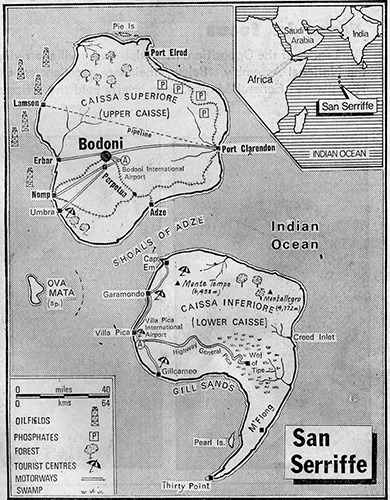
The reason that even people who do not care one bit about typography know several fonts and some specialist terms, is the personal computer. Specifically, the first Mac. Steve Jobs had attended a calligraphy class in college which left such a great impression on him that he pushed hard to have several typefaces included on the first Mac. At the time, this was a revolutionary concept but it set in motion the proliferation of digital fonts we know today.
Digital typography (mid 1980s – present)
Bitmap (raster) fonts: a data file that contains glyphs in pixel form. Because it is not scalable like a vector, a bitmap font must contain many sets of pre-determined sizes (traditionally just 8, 9, 10, 12, 14, 18, 24, 36, 48, and 72pt), each in every permutation of regular, bold, and italic.
Bitmap font formats: PCF, BDF, SNF, DWF, BF, AFM, FON, BMF, PSF, PK
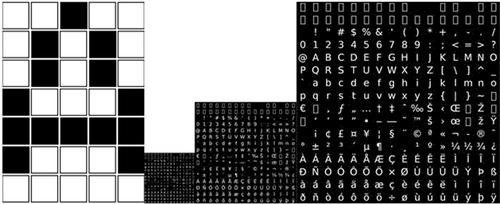
A pixilated bitmap character (image from Wikimedia Commons) and bitmap files for 3 font sizes (image fromJOT)
Outline (vector) fonts - sets of mathematically described lines and curves that trace the outline of glyphs. They are infinitely scalable without pixilation.
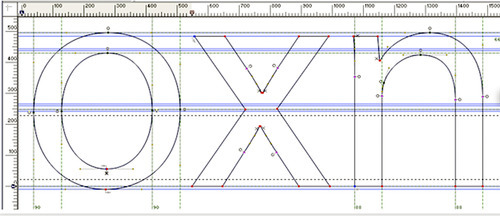
Vectorized font (image from Adobe)
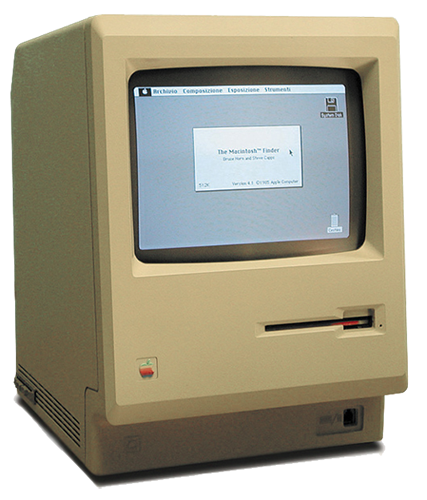
The computer era came with the promise of unlimited font choices.
Fonts soon got used in grotesque ways, the worst offender being Comic Sans, a quirky hand-writing font distributed through Microsoft’s operating system. Intended as a script for an animated dog, Comic Sans became popular because it was part of Microsoft Windows’ standard font package.

Since everybody had a PC, fonts in Windows became pretty much default standards. The rise of Times New Roman, for example, is directly correlated with this phenomenon.
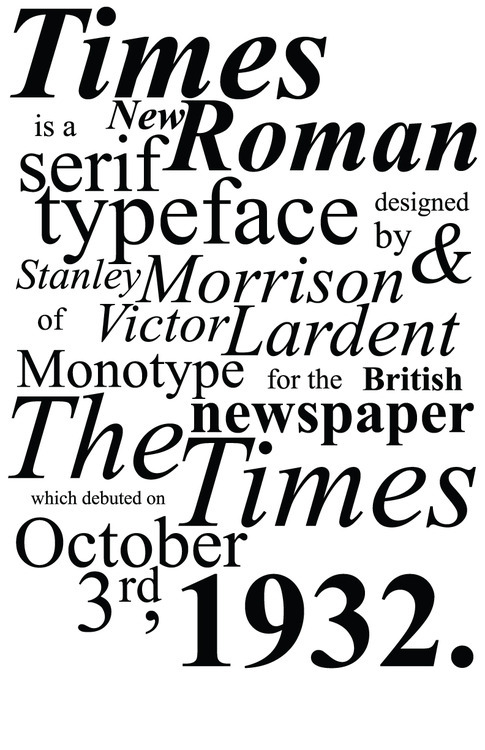
For a long time, the Internet ran on a few fonts, namely those available on most computers. A few years ago this changed with the introduction of CSS3 and faster broadband speeds. Now, websites can display fonts delivered through the web and the world is better of because of it.

2007 On September 25, 2007, Vicki Walker put this in an email and pushed send: TO ENSURE YOUR STAFF CLAIM IS PROCESSED AND PAID, PLEASE FOLLOW THE BELOW CHECKLIST. Her company in New Zealand did not like her use of the caps lock button and fired her for sending “confrontational emails”. Walker won damages in court but the episode tells us something about the power of typography. We don’t like to be screamed at in our face and WE DON’T LIKE TO BE SCREAMED AT ON OUR SCREEN. LET THAT BE A LESSON FOR ALL OF US.
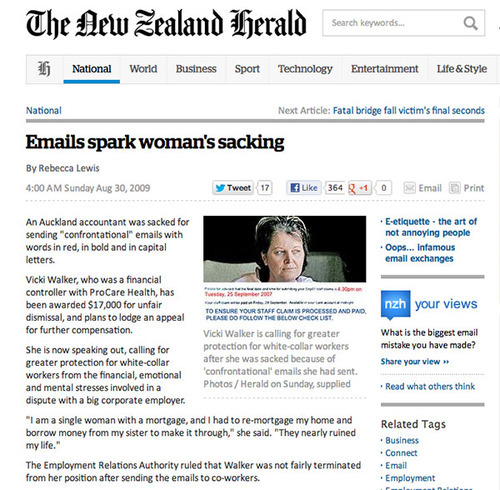
What are the most popular fonts of all time? The poster below combines various Top 100 lists and puts Helvetica, Futura and Bodoni in the top three spots.
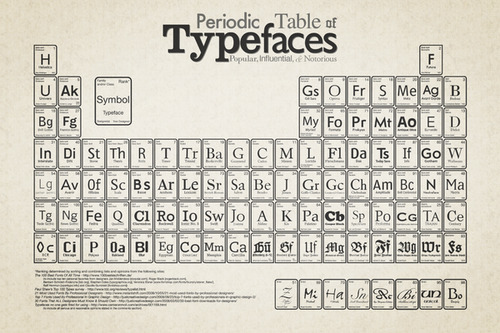
Typeface Terminology
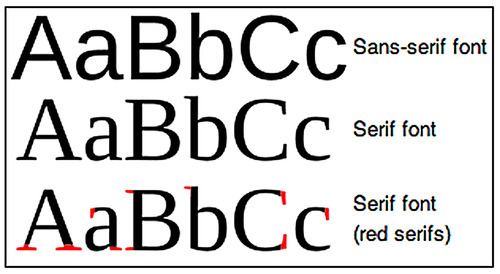

Works inspired by typeface design
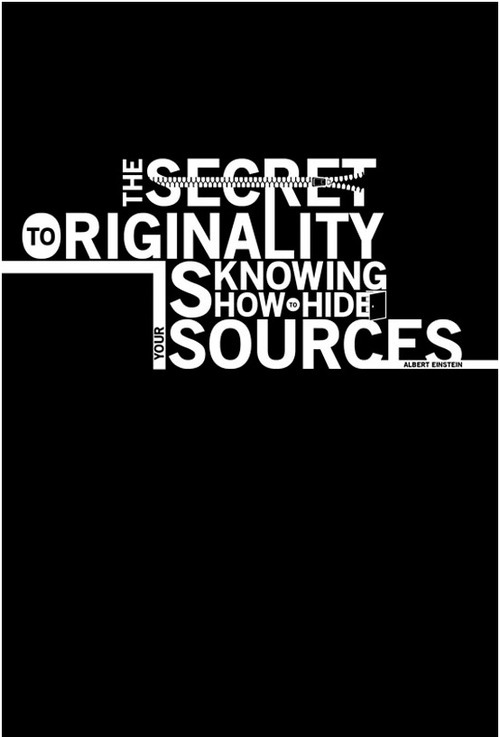
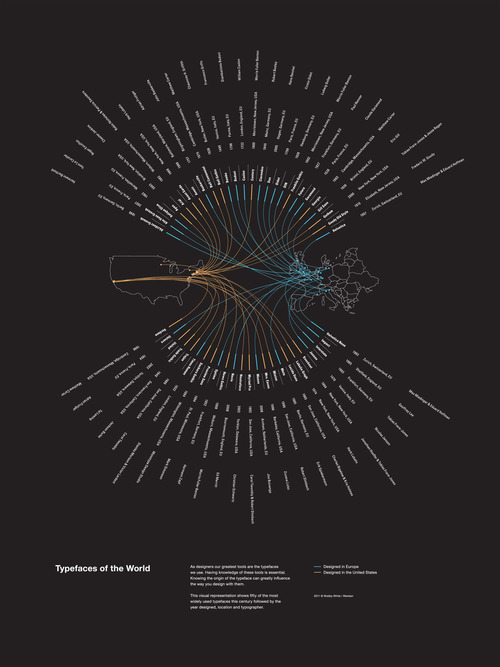
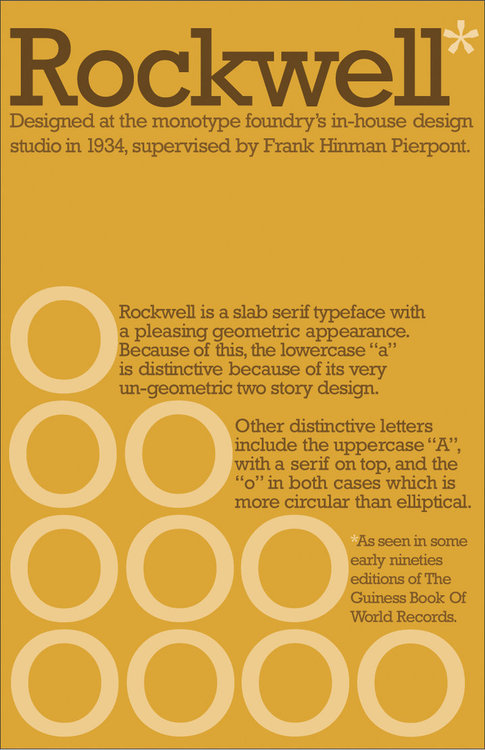
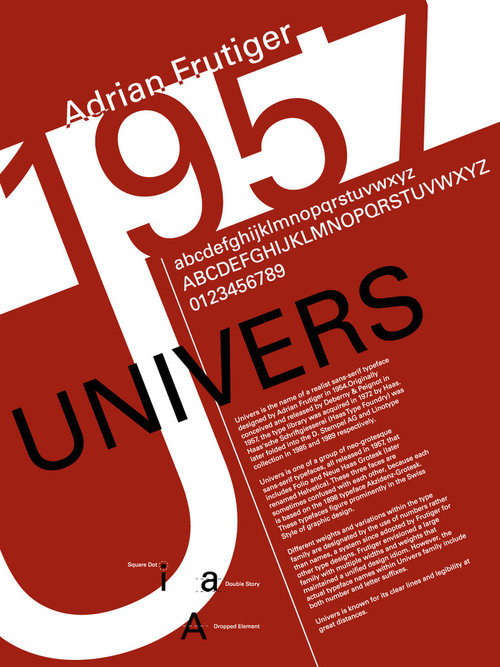
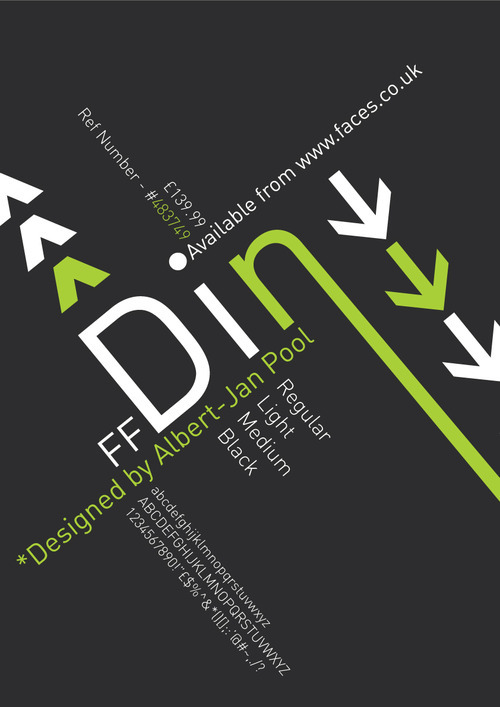
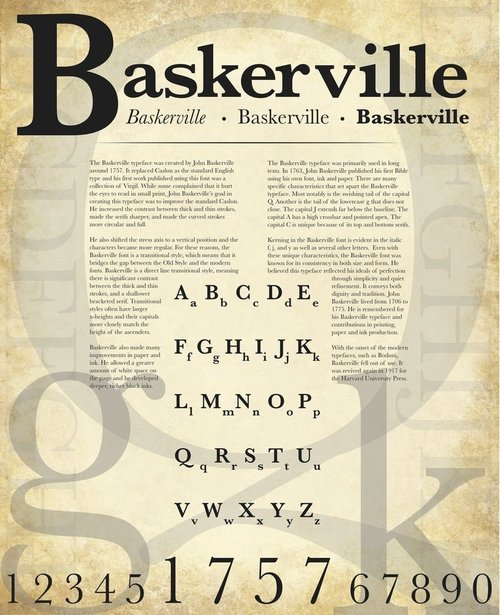

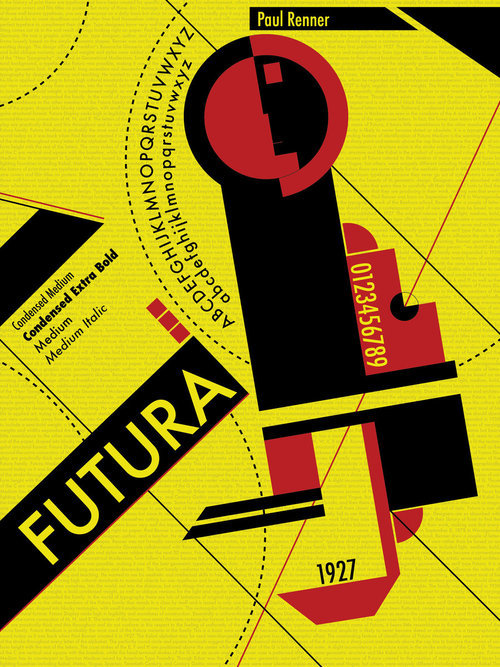
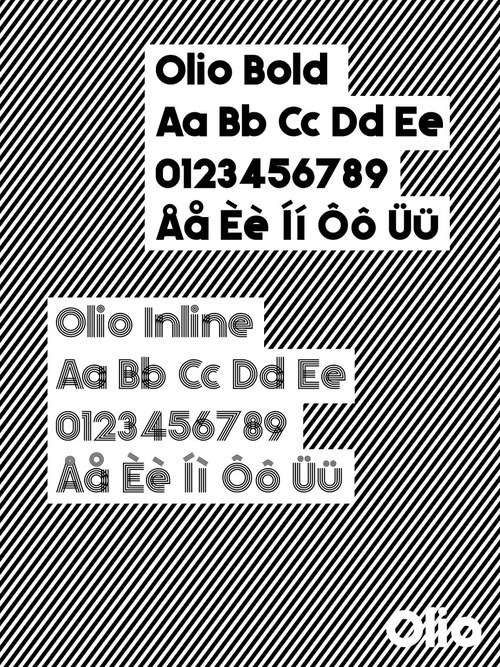
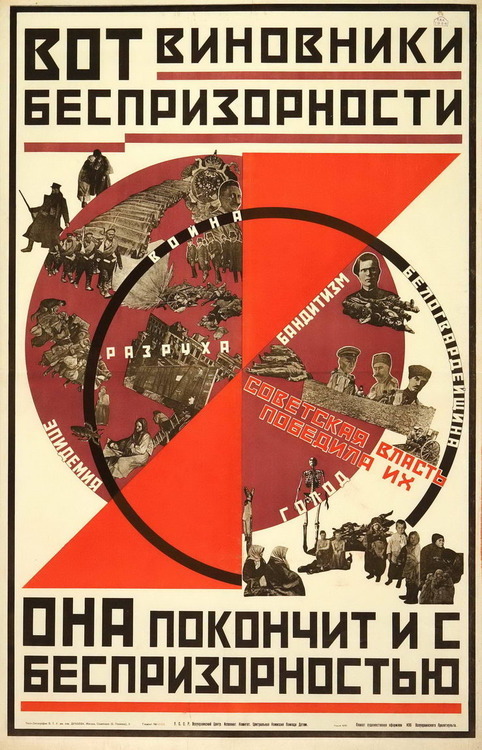
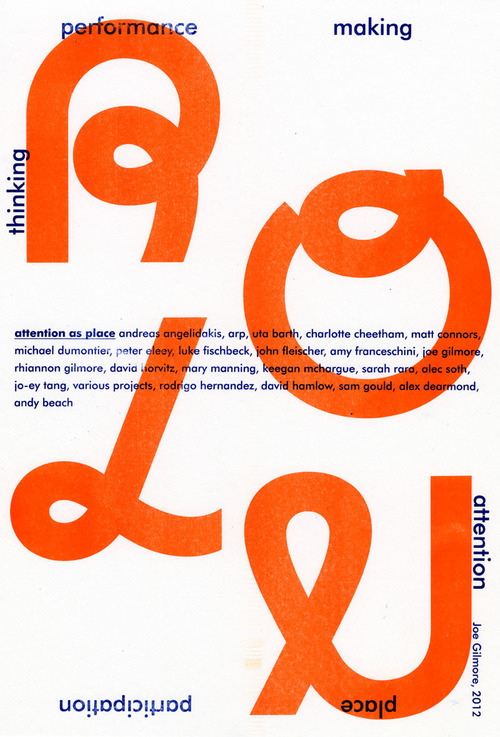
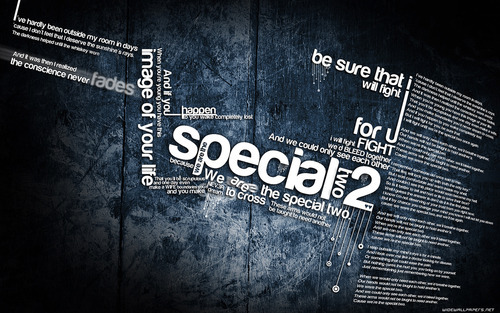
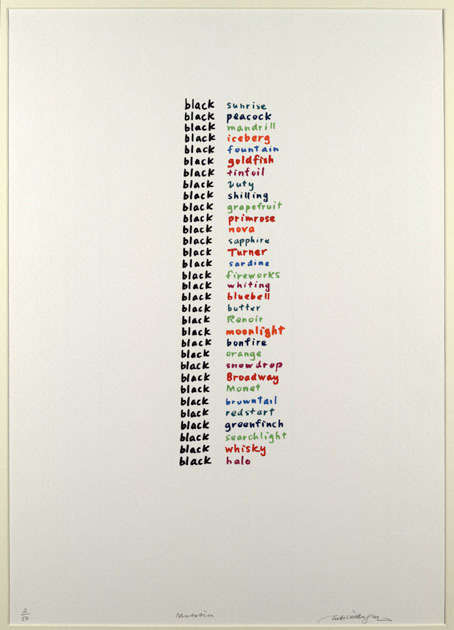
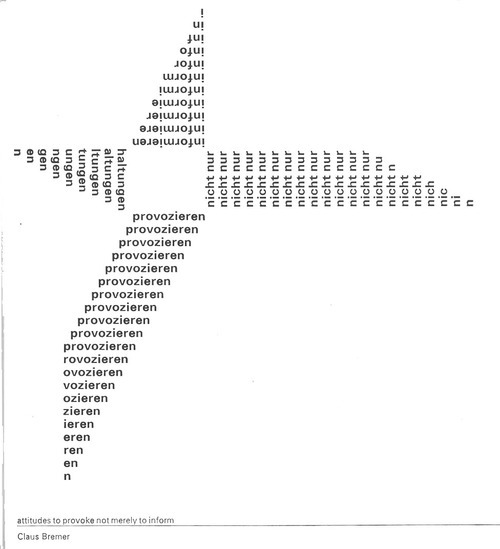
2 notes
·
View notes
Photo
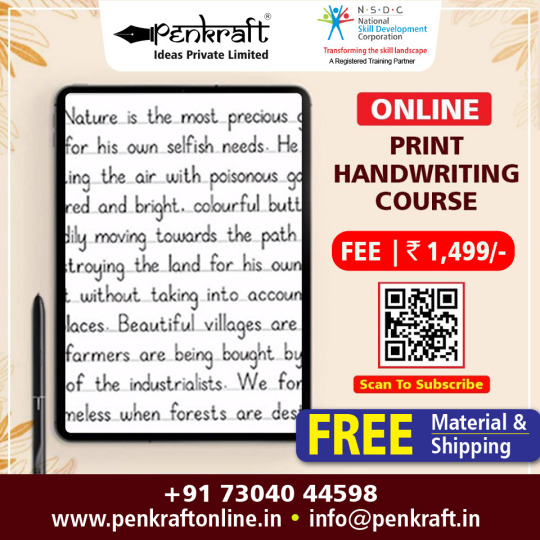
Penkraft proudly offers its Online Print Handwriting Improvement Course for children of 4 years onwards.
0 notes
Text
printable coloring pages for kids
Coloring is a simple pastime that fosters creativity, cognition, and psychology in both children and adults. Coloring pages are very popular with children. If you have children or enjoy coloring, you can download printable coloring sheets and print them out for yourself and your children. These pages can be used to teach your children how to color various objects, such as flowers and doodles. We'll look at the advantages of printable coloring sheets for both youngsters and adults in this article. Continue reading to learn more.
1. Improvements in motor skills
To begin, you can select from hundreds of thousands of templates available online and then print them. Your children's motor abilities will improve as a result of coloring these pages. In fact, the precise grip, action, and motion can assist your children improve their wrist, hand, and finger muscles.
Improved motor skills can help your child write more fluently and learn to handle little objects with care. They can improve these talents over time, allowing them to become far better typists and athletes.
2. Increased Participation
The majority of children nowadays receive their primary education at school. They follow a set rhythm in school, which includes written course work, weekly or monthly assessments, and assignments.
Additionally, printable coloring pages, books, and sheets can assist your children in preparing for more structured activities. Furthermore, this activity is highly engaging, and most children remain engaged throughout the session.
3. Increased Creativity
You may fuel your imagination by downloading printable coloring pages that boost creativity. Coloring, in reality, instills a sense of creativity and allows you to recognise the visual distinctions in a work of art.
Furthermore, coloring can stimulate the imagination and encourage your children to come up with new ideas and learn to think outside the box in a natural way. We also know that originality is highly recognised in every area around the world.
4. Improved Handwriting
You must improve your hand strength, dexterity, and attention to detail if you wish to write cursive scripts and printed characters. As a result, you can enhance all of these skills by starting with printable coloring pages.
The same is true for children. Allowing your children to color printable coloring sheets will help them write more freely and organically. When it comes to coloring or writing with a pencil, they will be considerably more proficient.
5. Improved perception, discernment, and recognition
Colors come in a variety of names and hues. It takes a lot of practice to learn to distinguish between different colors and memorize their names. Coloring pages can help you out in this situation.
Coloring pages that are printable can help your children learn about different colors and tints. So, if you want your children to increase their color awareness and recognition, try using printable coloring pages.
The majority of kids enjoy coloring and consider it to be one of the most enjoyable recreational activities. It can also aid in their psychological and physical growth. As a result, specialists advise that you encourage your children to participate in this activity.
In conclusion, if you want your children to benefit from all of the advantages discussed in this article, we recommend that you get the printable coloring pages for kids and acquire some printouts to get them started. We're sure that will pay off for the rest of your life.
0 notes
Text
5 Reasons to subscribe Penkraft Online Course

5 REASONS TO SUBSCRIBE PENKRAFT ONLINE COURSE
Introducing Penkraft's NEW Online Courses where you can learn a variety of courses ranging from Calligraphy to Abacus to Madhubani, and most importantly Handwriting Improvement. Calligraphy is a highly unique handwriting-based art form. Within the Online Calligraphy course, you will learn techniques and different types of calligraphy fonts using various and distinct calligraphy pens. Also available in online art form courses are Madhubani Painting, Warli Art, Mandala Art, Gond art and many more. For each course, Penkraft will teach you the right method, right techniques and guide you towards the right equipment or material to use. Online Abacus and Handwriting improvement course are especially suited for kids. In this course kids can learn abacus and improve handwriting within the comforts of their homes while also being able to practice, taking advantage of the Penkraft kit included with the subscription. Online Handwriting course will also explain print, Devanagari and cursive font/form. Reasons to subscribe to Penkraft Online Courses.
Learn at your own place and pace Penkraft Online Course is available worldwide. You simply just have to log in to Penkaft website or Penkraft app. You can watch the course videos on demand in your home, school or office on any device. Learning online provides you with the flexibility you desire. Affordable price: Price of the course is affordable which also includes all the materials (i.e. Penkraft Kit) related to the online Course. The knowledge you are going to get from these courses is of pristine quality, that will help you to improve your skills and provide you with the correct technique to make marvels with the particular art form. Easy accessibility Penkraft Online Course is accessible on a mobile phone, tablet, laptop, and desktop. You can watch course videos on any resolution or any device. Certified Course On completion of the course, a digital certificate will be awarded to you! Which you can then add to your resume or showcase elsewhere!
Penkraft Kit Each course has its own unique requirement of materials. This is included in the kit without any extra fees when purchasing subscriptions of these online courses.
So this was the reason why you should enroll for Penkraft online course. Do visit the website start your course now. https://www.penkraftonline.in//
Penkraft conducts classes, course, online courses, live courses, workshops, teachers' training & online teachers' training in Handwriting Improvement, Calligraphy, Abacus Maths, Vedic Maths, Phonics and various Craft & Artforms - Madhubani, Mandala, Warli, Gond, Lippan Art, Kalighat, Kalamkari, Pichwai, Cheriyal, Kerala Mural, Pattachitra, Tanjore Painting, One Stroke Painting, Decoupage, Image Transfer, Resin Art, Fluid Art, Alcohol Ink Art, Pop Art, Knife Painting, Scandinavian Art, Water Colors, Coffee Painting, Pencil Shading, Resin Art Advanced etc. at pan-India locations. With our mission to inspire, educate, empower & uplift people through our endeavours, we have trained & operationally supported (and continue to support) 1500+ home-makers to become Penkraft Certified Teachers? in various disciplines.
0 notes
Text
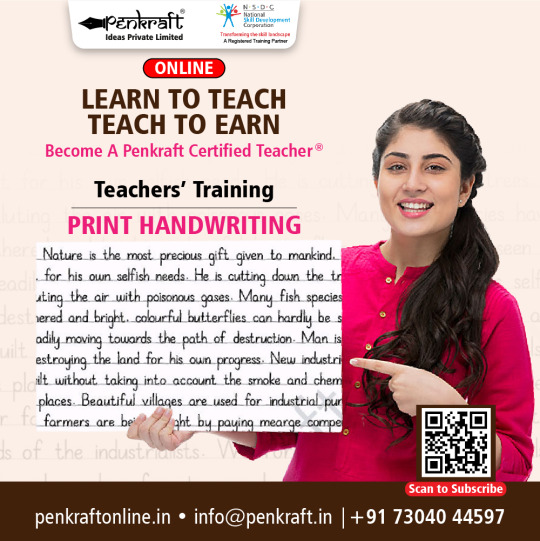
#Print Writing#Handwriting Improvement#Print Handwriting#Print Handwriting Improvement#Print Handwriting Improvement Course#Print Handwriting Improvement Classes#Print Handwriting Improvement Online Course#Print Handwriting Improvement Online Classes#Online Print Handwriting Improvement#Online Print Handwriting Improvement courses#Print handwriting improvement for kids#Print handwriting improvement for children#Print handwriting improvement for students#Print Handwriting Improvement training#Certified Print handwriting improvement course#Print Handwriting Improvement Classes near me#handwriting Improvement certificate#Handwriting improvement course#Handwriting improvement classes#handwriting Improvement certificate online#handwriting courses#handwriting courses online#handwriting classes#handwriting classes for kids#handwriting classes near me#penkraft#penkraft certified course#penkraft near me#penkraft certified online course#how to improve handwriting
0 notes
Text
The Tale of a Desk
I finally have a functioning desk setup!!
My History with Desks:
I have been needing a new desk setup for months now. From May 2020 up until this past February. That may come as a shock to you as this past year being the working and schooling from home era, desks were a necessity.
I've had a desk for the majority of my life. My childhood bedroom set came with a desk, then I later bought a replacement before I went off to dorm where bedroom desks were a given. Even though I've always had desks rarely did I fully utilize them. My childhood desk was a catch-all during my sloppy phase. It held books, school papers, clothes, hair products, everything!! Because of this I never used it to study, do homework, or even read as the entirety of its surface area was occupied. Fast forward to my late teen years I wanted to get rid of the desk. I was aware that the desk was causing more harm than good, feeding into my clutter habit. So I downsized to a small desk that I intended to use as a vanity since I wasn't going to lie to myself and say that I'd actually do any work on it. I still have it to this day, it's still fulfilling the role of a vanity as I store makeup and hair products there but it's too small to function as a desk for me.
When I went off to dorm for college I had no choice but to finally use a desk. I was determined to do well in school and I knew that the best way to limit procrastination was to separate my areas of work and rest. It also helped that in the tiny room that I shared with another person that it was the only seating with a flat surface in front of it. Instead of using a dining table for a desk (as I had been for most of my life) I was using a desk as a dining table. The truth of its role was a constant reminder to get work done. When I returned to college again last year I fell back into the routine of getting most of my work done at my desk. However, once the panoramic pandemic hit I wanted to not only separate work and rest but also put creativity in its own realm. At this point, I was still dorming but my roommate had left so I had an extra desk.
I made that my creative space. I would paint, read and even edit videos at that desk. I loved having a designated fun space and it helped me out of a couple cycles of the lockdown blues. When that semester ended it was time for me to move on and out, I rented a small room in Brooklyn. Sadly there was no space for a desk so I couldn't create a solid work or creative space there. I would do whatever work I had in bed and but it was only a temporary stay so I made it work. After 3 months of renting that room, I went off to rent my own apartment! I was ecstatic but slightly broke. I had just put down over $5k to move in and I had to spread out my furniture purchasing. For about the first 6 months of my living in this apartment, I had no desk OR dining table. This is especially wild since I worked from home for months. I moved my vanity desk from my childhood home into my space but it was too small for what I needed plus I didn't have any chairs. I spent the first three months furnishing in other ways as to not completely blow all my money in one go. The last 3 months were spent hunting for a desk. Now I know what you're thinking, "It doesn't take that long to find a desk", but in a pandemic it does!
I had a particular size and style in mind to match my current space and the options were limited so I was saving. The first desks that I was looking at were upward of $200 so I had to double-check my decision and would then always change my mind. One day I had FINALLY decided on a desk but two issues arose. One, it was constantly out of stock in the color that I wanted. Two, the shipping was $50. The desk I ended up getting ended up being around $90 but it was coming from IKEA and they don't do free delivery. This lead to me trying to bulk up my order so that the purchase would be "worth it". I finally bit the bullet in February as the $50 on top of the actual price of the desk still kept me under my original budget.
How I Will Use the Desk:
With this desk, I had a few things in mind. Yes, this is a working space (typing this on her right now) but I also wanted it to be my creative space. Since I'm not in school and I go out for my job all the work that I do at this desk is leisurely work. Education and self-administered projects that I do for me and me alone. Because of that, I don't feel the same need I did when I was in school to separate creative space from working space. At this desk, I will continue to learn and grow in whatever avenue that piques my interest. I will hone my writing, study math, edit videos, paint, and oftentimes eat at my desk ( still don't have a dining table).
When I have the time and energy I choose a subject to learn or introduce myself to. Some of the educational work I have done on my own time have been; using Codecademy to learn the basics of different coding languages, taking Coursera courses on whatever they are offering for the great price of free, use my college provided Linkedin Learning account to learn the basics and intricacies of a variety of topics and currently I am teaching myself statistics through Khan Academy. I love to learn even about things that don't immediately impact me. My true goal in life is to learn about as many things as I can and those online resources that I mentioned are just a few ways that I work on my never-ending status of being a student.
Let's talk a little more about the creative side of this desk. I already told you about some of the fun things that I will do here but let's dive into it a little more. I have been writing and editing more even before I got this desk since I started working on this blog and posting videos for it but I want to expand. When it comes to writing I want to improve not just my grammar and wording but also my physical handwriting. I have pretty bad handwriting, certified chicken scratch, and I plan on improving that. This will probably be a project that goes across several years but we all need a starting point and mine was simply to actually have a flat surface to write on. I started journaling before I had the desk to get some thoughts down and actually use my handwriting more often but I would have to cut it short since writing without a table or desk is pretty difficult to do for long periods of time. Now with this desk and the excess of time caused via coronavirus I can easily journal two pages without my wrist crying out for help. Today I even started to watch some videos on how to improve my print. The true goal is to be able to produce amazing calligraphy but I understand the value of baby steps so I will start off small for now.
I will especially plan at this desk! I love to plan out my days, weeks, goals, habits, whatever comes to mind I will try to plan for it. However, it felt somewhat counterproductive when I would hunch forward in bed to plan out my day and week for productivity. I plan my best when my mind and body feel good and planning with poor posture didn't make sense.
Hobbies I plan to test out/improve that benefit from having a desk
calligraphy
editing
painting
sketching/ drawing
planning (yes it's a super fun hobby, fight me in the comments)
people watching through my window
comment how you're personally enjoying your desk besides school and work
Simply Benefits of Having a Desk:
The separation between leisure and work. I have goals with my home studies, I don't have goals for my streaming consumption.
I have already felt an increase in productivity. Since I know have a designated space to work it is easier to focus. It has even made falling asleep easier. With my bed no longer being a place of productivity I can sleep easier and faster with far fewer tossing and turning.
My room is less empty. I moved into my current apartment around 6 months ago and it is still pretty bare. Having this desk take up some of the blank white space feels good and makes me happy when I see it.
I'm not sure what my desk status will be in my next home but hopefully, it takes less time to figure out.
Thank you for reading, I hope you enjoyed it.
0 notes
Link
Penkraft proudly offers its Online Print Handwriting Improvement Course for children of 4 years onwards.
0 notes
Text
How To Have Your Vision Board Ready To Start 2021
New Post has been published on https://perfectirishgifts.com/how-to-have-your-vision-board-ready-to-start-2021/
How To Have Your Vision Board Ready To Start 2021
The end of the year is the perfect timing to reflect on how your year turned out and how you plan to make it even better. 2020 particularly, is an odd year with all the Covid-19 crisis. You probably left many of your goals behind, but indeed you accomplished others that you had not considered. It is an excellent starting point to think of a long-term purpose that makes you happy, considering you as a whole person, not just a parent or an executive, and make it flexible enough to allow for change.
The vision board is the simplest way to capture your vision and strategy at a glance. Some people use it for personal matters, others only for business strategy and product development. I would suggest you have your personal vision board, including all the aspects of your life that you want to prioritize next year.
How to start?
Look for a giant board, white or black, whatever is more comfortable for you. You can also use a flipchart, or if you want to share it with someone else, you can also use online brainstorming tools, such as Mural.co. You can even use a wall or a window and post-its, you don’t need to spend any money upfront. I would not recommend using a Word document or an A4 sheet only. Take this time to expand your mind by using a format that doesn’t limit your thoughts, something big.
Some things to consider:
– Handwrite your goals instead of typing them, it helps you embrace them. Computers may dominate our lives, but research suggests handwriting brings us significant cognitive benefits, such as improving learning and retention.
– Keep the board handy. Visualization is a powerful mind exercise. According to the popular book The Secret, “The law of attraction is that you become what you think about.” It recommends holding images of what you want in your mind, helps you improve your focus and attention, therefore increasing the odds of achieving it. You can include pictures, colors or anything you want to make you feel blissful when you see it. Feel that you achieved it before you actually did. What you focus on expands. Olympic medalist Michael Phelps would picture in his mind “a tape” of him swimming every day and night.
– Try to do this activity in an hour or so, nonstop. Let your mind guide you, and plan to prevent interruptions by blocking or silencing your phone or doing it at a time of the day when you are alone and feeling energetic. A Saturday morning or Sunday afternoon could work, to make you feel like you are not working, this is part of your life planning,
How to do your vision board
Your vision board should focus on the things that you want.
1) Write down the scope of your vision board. Remember this should be a long term exercise, such as 2021-2025. So you are going to write down the things you want to work on and improve in the next five years.
2) Write down your goal. Who you want to become or be known/recognized for. Example: I want to be a coach who empowers people to take action and cultivate their authentic selves.
3) Think of the main categories you want to work on, which are how the goal statement will be achieved. Ideally, no more than five. Write them down across your board. The categories could be about self-development, self-care, writing, leading a team, developing a business or business unit or creating a new product. Think basically about how you want your week to be. Your week should be full of these five categories of activities. You can even assign them a priority number and a day of the week to achieve them.
4) Then, continue writing down what you need to do to achieve that specific category. Examples are creating a weekly newsletter, journaling at night, taking a course or contacting new clients. There is no specific order or way to do this. It depends on how your creative mind works. I prefer using a tree diagram to break down each major headline into smaller boxes or tasks, similar to an org chart. You can also use mind mapping, a tool very much used in design thinking: write the title of the subject or project that you’re exploring in the center of a page and draw a circle around it. Then draw lines out from this circle to connect with the subheading or subcircles, and so on. Other ways to do it is by using post-it notes, stickers, drawings or images. Bur remember to connect them. It must look like a net. If the ideas are not connected to the main goal and each other, you will have a hard time making them work for you. It will be like multitasking, and you want to avoid that. Focusing on one goal is essential. Go down no further than three levels of details on your board, otherwise, it is going to too much information to visualize.
5) You can include the impediments or potential block roads you may have to tackle on one side of the board.
6) You can also do an exercise trying to remember what worked well last year, what did not work well, and what to continue, and review your vision board to make sure you don’t stumble with the same stone.
7) Feel like you are done? Review it again, and make sure every activity that is included will make you happy. If not, try to see how you can eliminate it, reduce it or delegate it. Take a picture, and print it so that you can keep it safe. You can modify it later on, anytime.
Converting the vision board into actionable items
You have a vision board ready. Now what? Is that all? To make it work for you and avoid becoming just an adoration figure that seems more like a daydream, define actionable items and book calendar entries. That is, make it really part of your day-to-day. Define the tasks that you can achieve this week, next month and next year, and start assigning a specific date and time for each task. The recurrent ones, like writing, exercising or developing your employees, should have a weekly schedule. Block your calendar with those tasks.
Last but not least, be very specific about quantifying what you want to achieve. For example, how many clients you want to get per month? How much money do you want to make? How many stories do you want to write? Use these metrics to check your success.
Adjust the vision board, the tasks and the metrics as necessary; they are all yours. The vision board is a tool to empower yourself, not scare you, or paralyze you with fear. Get a coach or mentor to help you out, your future is worth it. The reason why you do it long-term is so that you think of the big picture, keep it present in your mind and take obstacles as opportunities to reconnect your activity net with new paths towards the same goal.
From Careers in Perfectirishgifts
0 notes
Text
Why do people go gaga over art inspired items?

Art is the source of magic in the material world. Art is what makes even the commonest thing look the most beautiful, therefore, it is likely that people have a fondness for art in general and anything that has rich elements of art in specific. Items of daily use and luxury items that we in the modern age use are mainly of the same mould that you would find in your neighbour's house. In such a case, the only thing that makes you stand out is the incorporation of art. Do we all not know how tea-pot looks or what purpose does it serve, then what makes us buy a new tea-pot every now and then? Yes, it is either the design or the print or the unique motif it has got etched on its surface. This viewpoint holds true for almost every art-inspired item. You don’t just buy the item, you buy a piece of art with you that you get to show off. Let us see what are the aspects that make art-inspired items stand out.
Innovation: Innovation always sells. Whenever you see any regular item in art-inspired design or texture, it suddenly becomes innovative, something that probably the consumer's imagination could never have mapped. Therefore, something like this also becomes a center of attention for the visitors to your house.
Elegance: One can't clearly explain this but it is true that anything that is art-inspired, naturally comes across as elegant. When items of regular use get a similar form, they don't just remain a utilitarian need but become collector's choice and this consequence largely arises because of the sheer elegance of art that the inspired items boast of.
Aesthetic sensibilities: Very often you&rsquo'll see that you get upset when you are out to buy a new sofa or a wardrobe because you don't get what you want because the stuff you are planning to buy is not matching your aesthetic sensibility. We all have an aesthetic sensibility and they vary as per our tastes in each other. This aesthetic sensibility is only satisfied with distinction in the design of every item, and that distinction is achieved by what kind of art it has inspired from.
Personal touch: Art-inspired items to speak of a different side in us to our friends or family. It is not necessary that you have to make something yourself to show an extension of your personality in that, even the reason that you have made a choice for that particular item is also reflective of who you are to the world around. This adds a personal touch to the items you buy.
Mostly handmade: Art-inspired items are usually handmade and you rarely get an exact copy of the same in the market. Even if you find the same design there will be a difference in some strokes or impressions on the surface. Handmade products always appeal to the consumer's choice because they are unique. Even popular opinion rates handmade products higher than large-scale manufactured products by connoisseurs.
Penkraft conducts classes, course, online courses, live courses, workshops, teachers' training & online teachers' training in Handwriting Improvement, Calligraphy, Abacus Maths, Vedic Maths, Phonics and various Craft & Artforms - Madhubani, Mandala, Warli, Gond, Lippan Art, Kalighat, Kalamkari, Pichwai, Cheriyal, Kerala Mural, Pattachitra, Tanjore Painting, One Stroke Painting, Decoupage, Image Transfer, Resin Art, Fluid Art, Alcohol Ink Art, Pop Art, Knife Painting, Scandinavian Art, Water Colors, Coffee Painting, Pencil Shading, Resin Art Advanced etc. at pan-India locations. With our mission to inspire, educate, empower & uplift people through our endeavours, we have trained & operationally supported (and continue to support) 1500+ home-makers to become Penkraft Certified Teachers? in various disciplines.
0 notes
Text
ACER ASPIRE 5 REVIEW: A $549 LAPTOP THAT DOESN’T COMPLETELY SUCK
The Acer Aspire 5 is a very functional laptop. I used it as my primary work driver for over a week, including the whirlwind that was Black Friday weekend. It loads the pages I need it to. It handles a heavy share of tabs and apps without burning itself up. It’s not seven pounds. Basically, it’s a $549 laptop that doesn’t completely suck.
There was a time when that would’ve made this the best budget laptop you can buy. But that time has come to an end, and the reason rhymes with “bay-MD.”
This Aspire 5 model has a four-core Intel Core i5-1035G1, the same budget- and midrange-oriented processor that powers Microsoft’s Surface Laptop Go. Performance-wise, it gets the job done — but its battery life is disastrous, and its integrated graphics are behind the times at this point. My advice: if you can get your hands on one, buy the AMD model with a six-core AMD Ryzen 5 4500U for the same price instead.
Starting with the design, which is the same across both models. I’d say the Aspire 5 looks fine — it’s no Dell XPS, but it’s still respectable from all angles. It comes in a few colors including silver and black. (I have the silver one, though I think the black looks a bit fancier myself.) Most of it is plastic, but the top cover (the part people are most likely to see) is aluminum. There’s some flex in the keyboard and the screen, but not so much that I worried about snapping the thing in half. It’s neither ultraportable nor overly clunky, weighing 3.7 pounds (1.8 kg) and measuring 14.3 x 9.9 x 0.7 inches. Students should note that while the Aspire isn’t terribly heavy, its breadth makes it a bit of a chore to fit in a standard-sized backpack alongside a load of books and binders.
A few other touches you might notice: Like the higher-priced Swift line, the Aspire 5 has a lustrous center hinge with “Aspire” printed across it, which is a nice bit of flair. The bezels, though, are quite large and very plastic-looking. The top one is particularly hefty.
All fair enough. At $549, I’ll take it. But it is worth noting that you don’t need to spend all that much more to get significantly higher build quality if you’re willing to compromise on screen size. The Acer Swift 3 (if you’ll take a 14-incher) is a nicer-looking, slimmer, and sturdier-feeling machine. Its Ryzen 5 4500U model is only $80 more expensive than this Aspire 5 on Acer’s website (and is even cheaper when it’s on sale).
ACER ASPIRE 5 SPECS (AS REVIEWED)
15.6-inch 16:9 display, 1920 x 1080
Intel Core i5-1035G1 (1.0 GHz with turbo boost up to 3.6 GHz)
8GB DDR4 memory
256GB PCIe NVMe SSD, one available hard disk drive bay
3.97 lbs (1.8 kg)
Ports: one USB 3.1 Type-C Gen 1, two USB 3.1 Gen 1 (one with power-off charging), one USB 2.0, one HDMI 2.0, one audio jack, one Ethernet (RJ-45), one DC-in jack
Windows Hello fingerprint reader
$549.99
“Pure silver” color option
The strength of such a large chassis, though, is that there’s room for a useful port selection. In total, we have one USB 3.1 Type-C Gen 1, two USB 3.1 Gen 1, one USB 2.0, one HDMI 2.0, and one Ethernet, as well as a power port. That’s comprehensive, though you’ll need to look elsewhere if you’re seeking Thunderbolt support, a typical omission in this price range.
The display is a bit of a dud on paper. I measured it as covering just 66 percent of the sRGB gamut and 50 percent of AdobeRGB. It also maxes out at 220 nits of brightness. Those are both mediocre as laptop screens go, though they’re not terrible for the category; color-wise, the Aspire actually scored slightly better than the IPS panel on the Swift 3, as well as the Asus VivoBook 15.
The viewing experience wasn’t as bad as those metrics might indicate. The matte panel did a good job of reducing glare; even around 90 percent brightness, I could use the machine outdoors without a hassle. And while Netflix and YouTube looked drab next to more expensive screens, media consumption is still very doable. (Especially because the audio is quite good. It has a nice surround quality and can easily fill a room — I’d put it on par with a decent external speaker. I could actually hear the bass and percussion in my music.)
The Aspire has a nice keyboard. It’s backlit and quiet with decent travel. (It’s mushier than it is clicky, if you have strong feelings about that.) There’s a numpad on the right side, which is a nice feature, but it does push the touchpad to the left. This was irksome for me as someone with small hands. The area that was natural for me to touch with my right hand was the right-click area. I had to intentionally stretch over to left-click, and I never really got used to it — even after a week and a half, I was still accidentally right-clicking all the time. There’s also an embedded fingerprint reader in the top-left corner of the touchpad, but its location wasn’t super convenient for me as a righty and I never ended up using it much.
AGREE TO CONTINUE: ACER ASPIRE 5 (2020)
Every smart device now requires you to agree to a series of terms and conditions before you can use it — contracts that no one actually reads. It’s impossible for us to read and analyze every single one of these agreements. But we started counting exactly how many times you have to hit “agree” to use devices when we review them since these are agreements most people don’t read and definitely can’t negotiate.
The Acer Aspire 5 presents you with multiple things to agree to or decline upon setup.
The mandatory policies, for which an agreement is required, are:
A request for your region and keyboard layout
Windows 10 License Agreement and Acer License Agreement
A Microsoft account for sign-in (this can be bypassed if you don’t connect the computer to the internet during setup)
A PIN
In addition, there is a slew of optional things to agree to:
Connect to Wi-Fi
Windows Hello fingerprint sensor authentication
Device privacy settings: online speech recognition, Find My Device, Inking and Typing, Advertising ID, location, diagnostic data, tailored experiences
Link an Android phone
OneDrive backup
Office 365
Let Microsoft collect information (including location, location history, contacts, voice input, speech and handwriting patterns, typing history, search history, calendar details, messages, apps, and Edge browsing history) to help Cortana provide personalized experiences and suggestions
Register for an Acer account
Enroll in Acer’s mailing list and the Acer User Experience Improvement Program (allowing Acer to collect information on your usage), and allow Acer to share contact details with Norton so it can send you updates about its pre-installed security software.
In total, that’s six mandatory agreements and 17 optional ones.
Of course, performance is what really makes or breaks a budget laptop. The base Aspire 5 configuration, listed at $399.99 on Acer’s website, can come with a Core i3-1005G1 or an AMD Ryzen 3 4300U (both with 4GB of RAM and a 128GB SSD). There are a number of models at different price points, including some with touchscreens. The system we’re looking at is listed at $549.99 on Amazon and has Intel’s four-core Core i5-1035G1, 8GB of RAM, and 256GB of SSD storage. A system with the same specs and a six-core Ryzen 5 4500U is currently listed on Acer’s website for the same price (though it’s hard to find and looks to be sold out on Amazon as of this writing).
It’s important to caveat here that I haven’t tried the AMD system yet — but the six-core 4500U is an impressive chip. In the $799 HP Envy x360 13 (which also has 8GB of RAM), it easily delivered the fantastic performance I’d expect from a Core i7, and it could even run Overwatch on its High settings at over 60fps. Make no mistake: the Intel Aspire 5 didn’t give me any problems during my various office work, social media, emailing, and the like. But performance wasn’t quite as zippy as it was on the AMD Envy. And I got the sense that the thing was chugging — I could almost always hear the fans spinning, even when I was just running a few Chrome tabs. I wouldn’t have wanted to try anything more intense (and unlike Intel’s new Iris Plus graphics, its UHD graphics aren’t a good choice for anything but the lightest gaming).
That’s before we even talk about the battery life. This Aspire 5 averaged four hours and 49 minutes of my daily workload (12-15 Chrome tabs, Slack, Spotify streaming, and occasional Zoom calls on the Battery Saver profile at 200 nits of brightness). That’s not good, and it’s especially not enough for students who are out and about all day. AMD processors, by contrast, have been killing it on battery: the 4500U-powered Envy could churn out eight hours of my typical workload while the Swift 3 with a Ryzen 7 4700U got up to seven hours, and the 4800U-powered IdeaPad Slim 7 achieved a monstrous 13 and a half hours.
Final note: there’s some bloatware. I got some annoying Norton pop-ups and occasional notifications from various other programs that came loaded onto the Aspire. These aren’t the end of the world at this price point, but note that you may have to take some time to uninstall if the alerts are bothering you.
So, look, the Aspire 5 gets the job done. It works. It does what you need it to (at least until the battery runs out). There are even a couple areas where it’s punching above its weight class — the audio is great, and it’s nice to have a fingerprint reader.
But if you can get all those benefits plus a six-core AMD processor for the same (or a comparable) price, I see no reason not to go that route instead if you’re wed to the 15-inch system. AMD systems are hard to find, but I recommend digging around or waiting until one becomes available. And if you’re willing to spend a bit more for the Ryzen-powered Swift 3, you’ll see a noticeable difference in build quality and portability as well as multiple extra hours of battery life. For students and on-the-go workers, I think that’s more than worth the cost.
0 notes